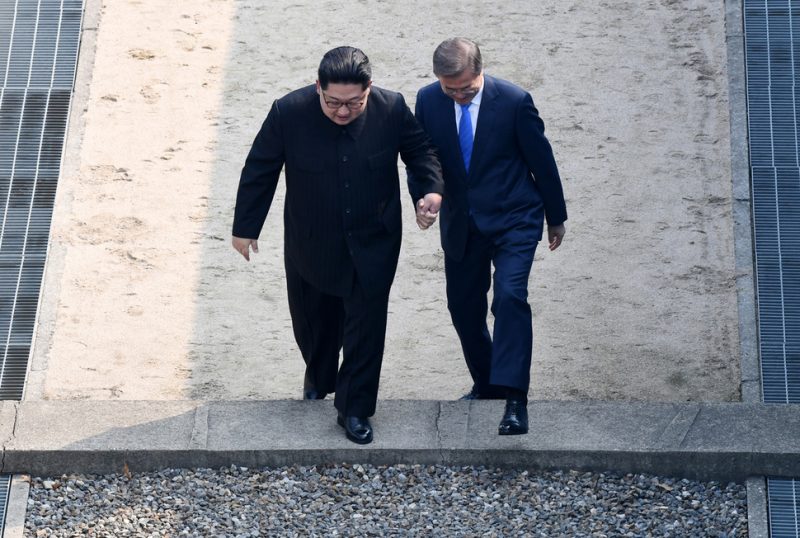
First published in late February, the following text is the transcript of Professor Michel Chossudovsky‘s presentation at the ROK National Assembly, 국회의사당, Seoul, South Korea, February 21, 2018 (see image below). This text also puts forth a North-South peace agreement proposal which hinges upon the annulment of the US-ROK Joint Forces Command which puts ROK forces under the command of the Pentagon.
The Korean language version of this text has been circulated widely among politicians and activists in the Republic of Korea.
Introduction
Fire and Fury” was not invented by Donald Trump. It is a concept deeply embedded in US military doctrine. It has characterized US military interventions since the end of World War II.
What distinguishes Trump from his predecessors in the White House is his political narrative.
We are nonetheless at a dangerous crossroads. Foreign policy miscalculation could lead to the unthinkable. Bear in mind that “MISTAKES” are often what determine the course of World History.
Insanity in US foreign policy, not to mention the fiction that nuclear weapons are an “instrument of peace” as formulated by the Trump administration could lead to the unthinkable. Decision-makers in high office believe in their own propaganda.
A Pre-emptive first strike US nuclear attack against North Korea could potentially precipitate a Third World War.
About-turn in January? President Trump not only confirmed his support for the North-South Pyeongchang inter-Korean dialogue, he also stated his resolve to establish a direct dialogue with Pyongyang. A few weeks later, this peace-making rhetoric was replaced by a new gush of military threats against the DPRK.
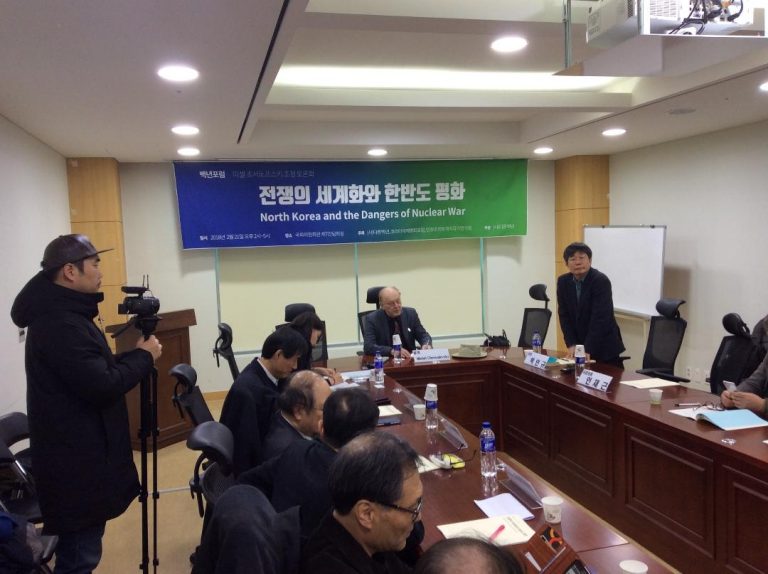
From a strategic point of view, the US is intent upon undermining the North-South dialogue. In recent developments, reported by the US media a “powerful military-intelligence faction within the Trump administration is pushing for a pre-emptive military strike on North Korea” to take place during or in the immediate wake of the Winter Olympics.
The operation is labelled by Washington as a “bloody nose” attack consisting of a either a conventional or low yield tactical nuclear weapon attack against North Korean’s missile facilities.
Even if nuclear weapons were not immediately used, the death toll in South Korea alone is estimated in the tens of thousands on the first day, in a conflict that could rapidly draw in nuclear-armed powers such as China and Russia.
Yet, such an act of recklessness and savagery is precisely what is being discussed, debated and prepared in the upper echelons of the White House and the US security-intelligence apparatus. Within top military-foreign policy circles, the advanced nature of the plans is so well known that it is generating fears and opposition. (Peter Symonds, Trump Considers “Bloody Nose” Strike on North Korea, wsws.org, February 6, 2018
The “bloody nose” is a “military concept” which is based on the notion that tactical nuclear weapons or mini-nukes are “harmless to civilians”, namely minimal collateral damage.
Meanwhile, the Winter Olympics have been accompanied by a process of inter-Korean dialogue and negotiation which is being boycotted by the US. What is at stake is a US led War against Peace.
The “More Usable “Peace-Making” Nuclear Bombs. The Mini-nukes
Trump’s 2018 Nuclear Posture Review is categorical in its resolve against North Korea. While the first strike pre-emptive nuclear doctrine was first formulated in 2001 under the Bush administration (NPR 2001 adopted by Senate in 2002), the 2018 NPR –which is coupled with a 1.2 trillion nuclear weapons program–, focusses on the development of “more usable” low yield nuclear weapons on a first strike basis against both nuclear and non-nuclear states.
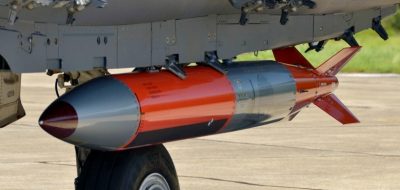
B61-12 Tactical Nuclear Bomb
The “more usable” nuclear weapons pertain to the so-called mini-nukes (B61-11, B61-12) with an explosive capacity of one third to up to twelve times a Hiroshima bomb. These “more usable” nukes, i.e. bunker buster bombs with a nuclear warhead, are said to be “harmless to the surrounding civilian population, because the explosion is underground” according to “scientific opinion” on contract the the Pentagon.
It is worth noting that in the wake of the Olympics, large scale joint US-ROK war games are envisaged.
There is a real danger that these joint war games could evolve towards active warfare, particularly in view of the pressures exerted within the US military-intelligence establishment to proceed with the so-called “bloody nose” option.
America’s commitment to the denuclearization of the Korean Peninsula as contained in the 2018 NPR is a smokescreen. The US has been threatening the Korean people with nuclear war for sixty seven years. The denuclearization of the Korean peninsula as formulated in the NPR is directed solely against the DPRK. It does not address the massive build-up of US nuclear capabilities.
It is worth noting, in this regard that the DPRK was the only nuclear weapons state which voted in favor of UN General Assembly resolution L.41 to convene negotiations on a “legally binding instrument to prohibit nuclear weapons, leading towards their total elimination”.
It is the more useable “peace making” bunker buster mini-nukes which may be contemplated under the “bloody nose” option for use against both North Korea and Iran.
Although the threats emanating from the US military-intelligence pertain to North Korea, under present circumstances, the Pentagon may choose to test the mini-nuke against a non-nuclear state.
The US historically has sought in major military operations to ensure that it’s close allies act on its behalf. Militarily the US would not act alone against North Korea. In this regard, what is also at stake is the US-ROK Combined Forces Command (CFC) which puts all South Korean Forces under the command of the Pentagon rather than under the jurisdiction of president Moon.
The refusal of South Korea to engage in war games must be categorical; the repeal of the US-ROK Combined Forces Command (CFC) is crucial. Without the ROK’s military engagement, the chances of the US acting unilaterally are significantly reduced.
The Breakdown in Diplomatic Channels
We recall the circumstances of the Cuban Missile Crisis, fifty-five years ago in October 1962.
What distinguishes October 1962 to today’s realities is that the leaders on both sides, namely John F. Kennedy and Nikita S. Khrushchev were accutely aware of the dangers of nuclear annihilation.
In contrast, president Donald Trump is misinformed regarding the dangers of nuclear war neither does he have concern in avoiding the massive killings of civilians: “We will have no choice but to totally destroy North Korea” accusing Kim Jong-un, of being a “rocket man” on “a suicide mission.”
What distinguishes the October 1962 Missile Crisis to Today’s Realities:
- Today’s president Donald Trump does not have the foggiest idea as to the consequences of nuclear war.
- The nuclear doctrine was entirely different during the Cold War. Both Washington and Moscow understood the realities of mutually assured destruction. Today, tactical nuclear weapons with an explosive capacity (yield) of one third to six times a Hiroshima bomb are categorized by the Pentagon as “harmless to civilians because the explosion is underground”.
- The diplomatic channels have collapsed,
- A 1.2 trillion ++ nuclear weapons program, first launched under Obama, is ongoing. Trump has allocated additional funds to this diabolical project
- Today’s thermonuclear bombs are more than 100 times more powerful and destructive than a Hiroshima bomb. Both the US and Russia have several thousand nuclear weapons deployed.
The positive aspects are that North and South have entered into a constructive dialogue coinciding with the Olympic games. Moreover, president Moon has also entered into meaningful discussions with China’s president Xi Jinping and Russia’s president Vladimir Putin. Beijing is fully aware that the deployment of the THAAD missiles in South Korea are largely intended to be used against China rather than North Korea.
Does the DPRK Constitute a Security Threat to the USA?
What most people in America do not know –and which is particularly relevant when assessing the alleged “threats” of the DPRK to World peace– is that North Korea lost thirty percent of its population as a result of US led bombings in the 1950s. US military sources confirm that 20 percent of North Korea’s population was killed off over a three period of intensive bombings:
“After destroying North Korea’s 78 cities and thousands of her villages, and killing countless numbers of her civilians, General Curtis LeMay remarked, “Over a period of three years or so we killed off – what – twenty percent of the population.”
Every single family in North Korea has lost a loved one in the course of the Korean War.
The US never apologized for having killed 30 percent of North Korea’s population. Quite the opposite. The main thrust of US foreign policy has been to demonize the victims of US led wars.
There were no war reparations.
The issue of US crimes against the people of Korea was never addressed by the international community.
The atrocities of the Korean War had set the stage for America’s war against the people of Vietnam.
For more than half a century, Washington has contributed to the political isolation of North Korea. Moreover, US sponsored sanctions against Pyongyang were intended to destabilize the country’s economy.
Propaganda has played a key role: The unspoken victim of US military aggression, the DPRK is portrayed as a failed war-mongering “Rogue State”, a “State sponsor of terrorism” and a “threat to World peace”. In the United States and Western Europe these stylized accusations have become part of a media consensus, which we dare not question.
The Lie becomes the Truth. North Korea is heralded as a threat. America is not the aggressor but “the victim”.
Historical Context: Nuclear War, Who is the Aggressor?
Confirmed by US military documents, both the People’s Republic of China and the Democratic People’s Republic of Korea have been threatened with nuclear war for sixty-seven years.
In 1950, Chinese volunteer forces dispatched by the People’s Republic of China were firmly behind North Korea against US aggression.
China’s act of solidarity with The Democratic People’s Republic of Korea (DPRK) was carried out barely a few months after the founding of the PRC on October 1, 1949.
President Harry Truman had contemplated the use of nuclear weapons against both China and North Korea, specifically as a means to repeal the Chinese Volunteer People’s Army (VPA) which had been dispatched to fight alongside North Korean forces. [Chinese Volunteer People’s Army, 中國人民志願軍; Zhōngguó Rénmín Zhìyuàn Jūn].
It is important to stress that US military action directed against the DPRK was part of a broader Cold War military agenda against the People’s Republic of China and the Soviet Union, the objective of which was ultimately to undermine and destroy socialism.
It is worth noting in this regard that according to a secret document dated September 15, 1945, “the Pentagon had envisaged blowing up the Soviet Union with a coordinated nuclear attack directed against major urban areas.
All major cities of the Soviet Union were included in the list of 66 “strategic” targets.
The tables below categorize each city in terms of area in square miles and the corresponding number of atomic bombs required to annihilate and kill the inhabitants of selected urban areas.
Six atomic bombs were to be used to destroy each of the larger cities including Moscow, Leningrad, Tashkent, Kiev, Kharkov, Odessa.
The Pentagon estimated that a total of 204 bombs would be required to “Wipe the Soviet Union off the Map”. The targets for a nuclear attack consisted of sixty-six major cities.
The document outlining this diabolical military agenda had been released in September 1945, barely one month after the bombing of Hiroshima and Nagasaki (6 and 9 August, 1945) and two years before the onset of the Cold War (1947).
The Hiroshima Doctrine” applied to North Korea
US nuclear doctrine pertaining to Korea was established following the bombings of Hiroshima and Nagasaki in August 1945, which were largely directed against civilians.
The strategic objective of a nuclear attack under the “Hiroshima doctrine” was to trigger a “massive casualty producing event” resulting in tens of thousands of deaths. The objective was to terrorize an entire nation, as a means of military conquest. In the words of President Harry Truman:
“The World will note that the first atomic bomb was dropped on Hiroshima a military base. That was because we wished in this first attack to avoid, insofar as possible, the killing of civilians..”(President Harry S. Truman in a radio speech to the Nation, August 9, 1945).
[Note: the first atomic bomb was dropped on Hiroshima on August 6, 1945; the Second on Nagasaki, on August 9, on the same day as Truman’s radio speech to the Nation]
There is a long history of US political insanity geared towards providing a human face to U.S. crimes against humanity. In this same radio address on August 9, 1945 president Truman (image right) concluded that God is on the side of America with regards to the use of nuclear weapons and that
“He May guide us to use it [nuclear weapons] in His ways and His purposes”.
According to Truman: God is with us, he will decide if and when to use the bomb:
We thank God that it [nuclear weapons] has come to us, instead of to our enemies; and we pray that He may guide us to use it [nuclear weapons] in His ways and for His purposes” (emphasis added)
The Truman doctrine emanating from Hiroshima has set the stage for the deployment of US nuclear weapons in South Korea. Barely a few years after the end of the Korean War, the US initiated its deployment of nuclear warheads in South Korea. This deployment in Uijongbu and Anyang-Ni had been envisaged as early as 1956.
It is worth noting that the US decision to bring nuclear warheads to South Korea was in blatant violation of Paragraph 13(d) of the 1953 Armistice Agreement which prohibited the warring factions from introducing new weapons into Korea.
The actual deployment of nuclear warheads started in January 1958, four and a half years after the end of the Korean War. Officially the US deployment of nuclear weapons in South Korea lasted for 33 years. The deployment was targeted against North Korea as well as China and the Soviet Union.
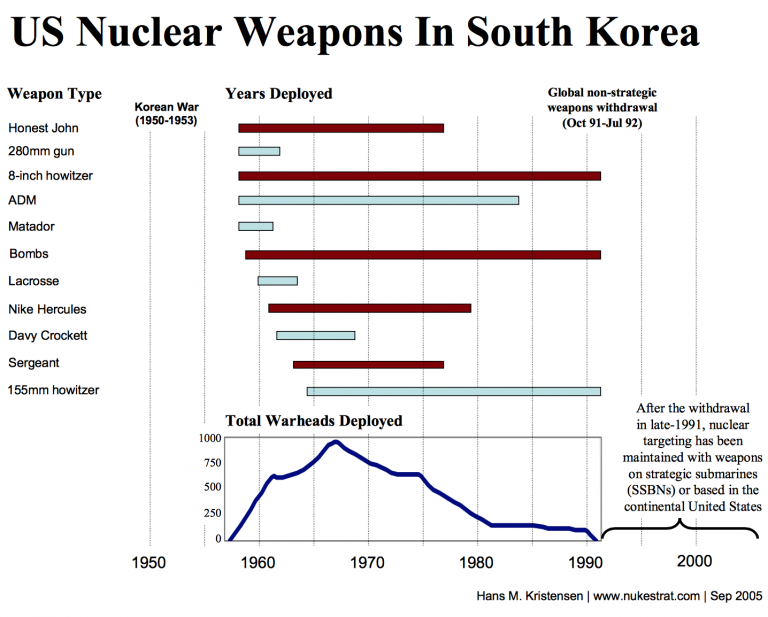
South Korea’s Nuclear Weapons Program
Concurrent and in coordination with the US deployment of nuclear warheads in South Korea, the ROK had initiated its own nuclear weapons program in the early 1970s.
The official story is that the US exerted pressure on Seoul to abandon their nuclear weapons program and “sign the Treaty on the Non-Proliferation of Nuclear Weapons (NPT) in April 1975 before it had produced any fissile material.” (Daniel A. Pinkston, “South Korea’s Nuclear Experiments,” CNS Research Story, 9 November 2004, http://cns.miis.edu.]
The ROK’s nuclear initiative was from the outset in the early 1970s under the supervision of the US and was developed as a component part of the US deployment of nuclear weapons, with a view to threatening North Korea.
While the West in chorus accuses the DPRK of developing nuclear capabilities, the development of a nuclear weapons program in South Korea was never an issue. Neither was the ROK designated as an undeclared nuclear weapons state.
Moreover, while this program was officially ended in 1978, the US promoted scientific expertise as well as training of the ROK military in the use of nuclear weapons. And bear in mind: under the ROK-US CFC agreement, all operational units of the ROK are under joint command headed by a US General. This means that all the military facilities and bases established by the Korean military are de facto joint facilities.
The Planning of Nuclear Attacks against North Korea from the Continental US and from Strategic US Submarines
According to official statements, the US withdrew its nuclear weapons from South Korea in December 1991.
This withdrawal from Korea did not in any way modify the US threat of nuclear war directed against the DPRK. On the contrary: it was tied to changes in US military strategy with regard to the deployment of nuclear warheads. Major North Korean cities were to be targeted with nuclear warheads from US continental locations and from US strategic submarines (SSBN) rather than military facilities in South Korea.
Todays Double standards
While North Korea is said to constitute a nuclear threat, five non-nuclear states including Belgium, the Netherlands, Germany, Italy and Turkey have B61-11 tactical nuclear weapons made in America under national command.
These Five Countries are undeclared nuclear weapons states.
No Trump “Fire and Fury” directed against Holland or Belgium, which possess 40 nuclear weapons under national command. Compare that to the DPRK’s 10 nuclear weapons, heralded as a “threat” to the security of the Western World.
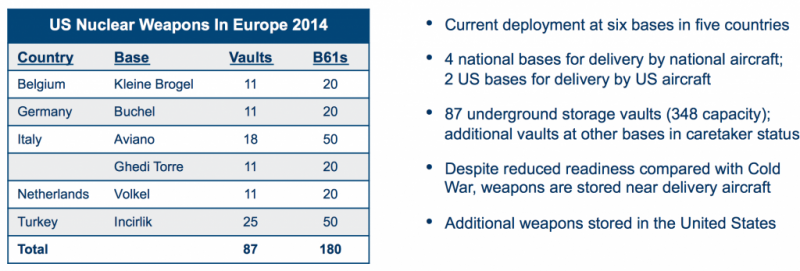
The Democratic People’s Republic of Korea, the unspoken victim of US military aggression, has been incessantly portrayed as a war mongering nation, a menace to the American Homeland and a “threat to World peace”. These stylized accusations have become part of a media consensus.
The threat of nuclear war does not emanate from the DPRK but from the US and its allies.
These continuous threats and actions of latent aggression directed against the DPRK should also be understood as part of the broader US military agenda in East Asia, directed against China and Russia. In many regards, from a geopolitical standpoint, the US considers the DPRK as a buffer state. The ultimate objective is to threaten Russia and China with the support of ROK forces (under the combined forces command). Needless to say, the reunification of North and South Korea would weaken US hegemony in North East Asia.
Moreover, Washington’s intent is to draw South East Asia and the Far East into a protracted military conflict by creating divisions between China and ASEAN countries, most of which are the victims of Western colonialism and US military aggression: Extensive crimes against humanity have been committed against Vietnam, Cambodia, Korea, the Philippines, Indonesia. In a bitter irony, these countries are now military allies of the United States.
It is important that people across the land, in the US, Western countries, come to realize that the United States rather than North Korea constitute a threat to global security.
Towards a Bilateral North-South Peace Agreement
The 1953 Armistice Agreement
What underlies the 1953 Armistice Agreement is that one of the warring parties, namely the US has consistently threatened to wage war on the DPRK for more than 60 years.
The US has on countless occasions violated the Armistice Agreement. It has remained on a war footing. Casually ignored by the Western media and the international community, the US has actively deployed nuclear weapons targeted at North Korea for more than half a century. More recently it has deployed the so-called THAAD missiles largely directed against China and Russia.
The US is still at war with North Korea. The armistice agreement signed in July 1953 –which legally constitutes a “temporary ceasefire” between the warring parties (US, North Korea and China’s Volunteer Army)– must be rescinded.
The US has not only violated the armistice agreement, it has consistently refused to enter into peace negotiations with Pyongyang, with a view to maintaining its military presence in South Korea as well as shunting a process of normalization and cooperation between the ROK and the DPRK. At this stage, the solution is for North and South to negotiate a bilateral peace treaty in defiance of the US refusal to enter into peace negotiations.
The avenue to achieving the ROK-DPRK Peace Treaty conducive to reunification requires the Repeal of the ROK-US Combined Forces Command (CFC) and the annulment of OPCON (Operational Control).
In 2014, the government of President Park Geun-hye agreed to extend the OPCON (Operational Control) agreement “until the mid-2020s”. What this signified is that “in the event of conflict” all ROK forces would be under the command of a US General appointed by the Pentagon, rather than under that of the ROK President and Commander in Chief. At present the US has 600,000 active South Korean Forces under its command. (i.e. the Commander of United States Forces Korea, (USFK) is also Commander of the ROK-U.S. CFC).
It goes without saying that national sovereignty of the ROK cannot reasonably be achieved without the annulment of the OPCON agreement as well as the ROK – US Combined Forces Command (CFC) structure. And this is something which President Moon’s government should envisage. The repeal of the CFC structure is a sine qua non to reaching peace and reunification.
As we recall, in 1978 a binational Republic of Korea – United States Combined Forces Command(CFC), was created under the presidency of General Park (military dictator and father of impeached president Park Guen-hye). In substance, this was a change in labels in relation to the so-called UN Command and the combined forces structures negotiated in 1950. During the mandate of President Syngman Rhee, all ROK forces were put under the command of General MacArthur:
“Ever since the Korean War, the allies have agreed that the American four-star would be in “Operational Control” (OPCON) of both ROK and US military forces in wartime …. Before 1978, this was accomplished through the United Nations Command. Since then it has been the CFC [US-ROK Combined Forces Command (CFC) structure]. (Brookings Institute)
Moreover, the Command of the US General under the renegotiated OPCON (2014) remains fully operational inasmuch as the 1953 Armistice (which legally constitutes a temporary ceasefire) is not replaced by a peace treaty.
If one of the signatories of the Armistice refuses to sign a Peace Agreement, what should be contemplated is the formulation of a comprehensive Bilateral North-South Peace Agreement, which would de facto lead to rescinding the 1953 armistice.
What should be sought is that the “state of war” between the US and the DPRK (which prevails under the armistice agreement) be in a sense “side-tracked” and annulled by the signing of a comprehensive bilateral North-South peace agreement, coupled with cooperation and interchange.
This proposed far-reaching agreement between Seoul and Pyongyang would assert peace on the Korean peninsula –failing the signing of a peace agreement between the signatories of the 1953 Armistice agreement.
The legal formulation of this bilateral entente is crucial. The bilateral arrangement would in effect bypass Washington’s refusal. It would establish the basis of peace on the Korean peninsula, without foreign intervention, namely without Washington dictating its conditions. It would require the concurrent withdrawal of US troops from the ROK and the repeal of the OPCON agreement.
Moreover, it should be noted that the militarization of the ROK under the OPCOM agreement, including the development of new military bases, is also largely intent upon using the Korean peninsula as a military launchpad threatening both China and Russia. Under OPCON, “in the case of war”, the entire force of the ROK would be mobilized under US command against China or Russia.
Moreover, Washington is intent upon creating political divisions in East Asia not only between the ROK and the DPRK but also between North Korea and China, with a view to ultimately isolating the DPRK.
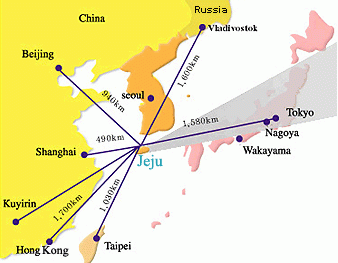
In a bitter irony, US military facilities in the ROK (including Jeju Island) are being used to threaten China as part of a process of military encirclement. Needless to say, permanent peace on the Korean peninsula as well as in the broader East Asia region as defined under a bilateral North-South agreement would require the repeal of both the Armistice agreement as well as OPCOM, including the withdrawal of US troops from the ROK.
It is important that the bilateral peace talks between the ROK with DPRK under the helm of President Moon Jae-in be conducted without the participation or interference of outside parties. These discussions must address the withdrawal of all US occupation forces as well as the removal of economic sanctions directed against North Korea.
The exclusion of US military presence and the withdrawal of the 28,500 occupation forces should be a sine qua non requirement of a bilateral ROK-DPRK Peace Treaty.
Reunification and the Road Ahead: There is Only One Korean Nation
There is only one Korean Nation. Washington opposes reunification because a united Korean Nation would weaken US hegemony in East Asia.
It would also weaken Japan. In this regard it is also important to address the bilateral relationship between the US and Japan, the former colonial power, which is directed against the reunification project.
Reunification would create a competing Korean nation state and regional power (with advanced technological and scientific capabilities) which would assert its sovereignty, establish trade relations with neighbouring countries (including Russia and China) without the interference of Washington.
It is worth noting in this regard, that US foreign policy and military planners have already established their own scenario of “reunification” predicated on maintaining US occupation troops in Korea. Similarly, what is envisaged by Washington is a framework which would enable “foreign investors” to penetrate and pillage the North Korean economy.
Washington’s objective is to hinder the process of reunification. Its Plan B would be for the US to impose the terms of Korea’s reunification. The NeoCons “Project for a New American Century” (PNAC) published in 2000 had intimated that in a “post unification scenario”, the number of US troops (currently at 28,500) would be increased and that US military presence would be extended to North Korea.
In a reunified Korea, the stated military mandate of the US garrison would be to implement so-called “stability operations in North Korea”:
While Korea unification might call for the reduction in American presence on the peninsula and a transformation of U.S force posture in Korea, the changes would really reflect a change in their mission – and changing technological realities – not the termination of their mission. Moreover, in any realistic post-unification scenario, U.S. forces are likely to have some role in stability operations in North Korea. It is premature to speculate on the precise size and composition of a post-unification U.S. presence in Korea, but it is not too early to recognize that the presence of American forces in Korea serves a larger and longer-range strategic purpose. For the present, any reduction in capabilities of the current U.S. garrison on the peninsula would be unwise. If anything, there is a need to bolster them, especially with respect to their ability to defend against missile attacks and to limit the effects of North Korea’s massive artillery capability. In time, or with unification, the structure of these units will change and their manpower levels fluctuate, but U.S. presence in this corner of Asia should continue. 36 (PNAC, Rebuilding America`s Defenses, Strategy, Forces and Resources for a New Century, p. 18, emphasis added)
Washington’s intentions are crystal clear. They consist in sabotaging the peace process.
Moreover, it should be understood that a US led war against North Korea would engulf the entire Korean nation.
While Washington claims to be defending South Korea, the US sponsored state of war is directed against both North and South Korea.
It also threatens the ROK which has been under de facto US military occupation since September 1945.
We are dealing with a diabolical military agenda: The US seeks under the Combined Forces Command to mobilize the forces of South Korea against the Korean Nation.
If a war were to be carried out, ROK forces under US command would be used against the Korean people’s reunification project. The annulment of the CDC is therefore crucial.
Given the geography of the Korean peninsula, the use of nuclear weapons against North Korea would inevitably also engulf South Korea. This fact is known and understood by US military planners.
What has to be emphasized is that the US and the ROK cannot be “Allies” inasmuch as the US threatens to wage war on the Korean Nation.
The “real alliance” is that which unifies and reunites North and South Korea through dialogue against foreign intrusion and aggression.
The US is in a state of war against the entire Korean Nation. It’s a war against peace. And what this requires is:
The extension of the bilateral talks between the ROK and the DPRK initiated on January 9, 2018 with a view to signing a tentative agreement which nullifies the Armistice agreement of 1953 and sets the terms of a bilateral “Peace Treaty”.
In turn this agreement would set the stage for the exclusion of US military presence and the withdrawal of the 28,500 US forces.
Moreover, pursuant to bilateral Peace negotiations, the ROK-US OPCON agreement which places ROK forces under US command would be rescinded. All ROK troops would thereafter be brought under national ROK command.
Bilateral consultations, which are currently ongoing, should also be undertaken with a view to further developing economic, technological, cultural and educational cooperation between the ROK and the DPRK.
Without the US in the background pulling the strings under OPCON, the threat of war would be replaced by dialogue. The first priority, therefore would be to rescind OPCON and the CFC.
Needless to say, the reunification of North and South Korea would weaken US hegemony in North East Asia.
It would also have significant implications with regard to trade and development in North East Asia.
A united Korean Nation of 80 million people, integrating the scientific and technological capabilities of North and South would inevitably lead to the formation of a powerful, self-reliant and sovereign regional economic power and trading nation.
A divided Korea serves the geopolitical and economic interests of the US.
The Olympic Games inter-Korean dialogue have set the Stage for Peace
What is now unfolding in the ROK is public acceptance of the inter-Korean dialogue.
Moreover, public opinion has become increasingly aware that any action taken by US-ROK forces under the combined forces command under the command of US General V. Brooks would constitute an attack against the entire Korean Nation.
The Olympics as well as the bilateral North-South negotiations provide an opportunity to eventually repeal the Combined Forces Command.
What is needed is a mass movement supportive of a government decision to unilaterally withdraw all ROK forces from the Combined Forces Command, namely a unilateral repeal of the CFC (which extends to 2025, signed in 2014, on the orders of Washington by president Park Geun-hye who was subsequently impeached).
The objective is to reinstate President Moon as Commander in Chief of ROK forces as a means to achieving peace.
This means that if the US still wants to attack the DPRK, it will not be able to rely on ROK forces, and historically the US has always relied on its allies to do the dirty work.
I think that the US will do its utmost to sabotage the North-South dialogue, while maintaining the combined forces command intact.
Text of Michel Chossudovsky’s presentation, Republic of Korea National Assembly, Seoul, South Korea, February 21, 2018
.
The original source of this article is Global Research
Copyright © Prof Michel Chossudovsky, Global Research, 2018
